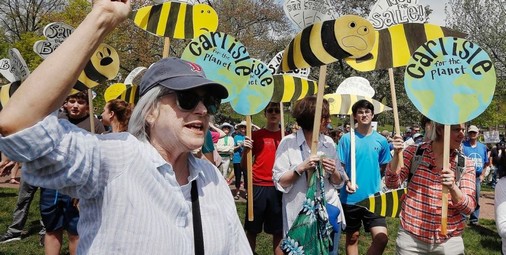Environmental Protesters Return to Washington as Trump Passes Milestone
Lacey Johnson and Ian Simpson,
Protesters marched in Washington on a second consecutive Saturday to challenge President Donald Trump’s stance on the environment and call on him to stand by policies to stop climate change championed by his predecessor.
Thousands of people gathered for the afternoon march from the lawn of the U.S. Capitol to the White House, an event that coincides with the completion of Trump’s first 100 days in office and the end of the traditional “honeymoon” period for a new president.
The Peoples Climate March, which drew about 15,000 people, according to an estimate by a Reuters reporter, rivaled last weekend’s March for Science in size. Protesters sounded many of the same themes at both events.
Carrying signs emblazoned with slogans such as “Imagine a world free a climate change,” and “Planet over profits,” demonstrators on Saturday said they were angered by the prospect of Trump carrying through on his vow to roll back protections put in place by his predecessors.
“We’re going to rise up and let them know that we’re sick and tired of seeing our children die of asthma,” said Rev. Leo Woodberry of Florence, S.C., who spoke during a press conference before the march. “We’re sick and tired of seeing people with cancer because of coal ash ponds. We’re sick and tired of seeing sea-level rise.”
Trump’s administration is considering withdrawing from the Paris Agreement, which more than 190 countries including the United States signed in hopes of curbing global warming. Trump has also proposed deep cuts for the Environmental Protection Agency.

In his campaign, Trump called climate change a hoax. Last month he kept a promise to the coal industry by undoing climate-change rules put in place by his predecessor, Democrat Barack Obama.
Tom McGettrick, 57, an electrical engineer who drove up from the Florida Keys to attend the march, said his main concern is the weakening of the EPA.
“Forty years of environmental protection has done wonders for the environment, especially in the Midwest,” said McGettrick, who spent most of his life in Michigan.
“When I was a teenager and went to Lake Erie, it was one of the most polluted bodies of water in the country,” he said. “Now when you go to Lake Erie it’s really beautiful.”
The Washington event, which coincided with Trump’s 100-day milestone, follows an exclusive interview with Reuters in which the president reflected wistfully at his life as a billionaire real estate developer that he left behind after his Jan. 20 inauguration.
“This is more work than in my previous life,” Trump told Reuters. “I thought it would be easier.”
Saturday’s march was part of an effort to build support for candidates with strong environmental records in the run-up to next year’s midterm elections and the 2020 presidential race, organizers said.
“We’re using this as a tactic to advance the strategy of building enough power to win on climate over the course of the long haul,” said Paul Getsos, national coordinator for the Peoples Climate Movement. Sponsors of Saturday’s events include labor unions, the Sierra Club and civil rights groups.
As a side theme, marchers will protest Trump’s crackdown on illegal immigrants and other issues championed by the maverick Republican billionaire.
Since Trump’s inauguration on Jan. 20, there have been national protests focused on issues ranging from abortion rights to immigration and science policy.
Myron Ebell, a climate change skeptic at the Competitive Enterprise Institute, a libertarian think tank, said the march would have little impact on the administration.
“The real decisions are made in this country in elections, and we have now a president and a House and a Senate that are determined to pursue a pro-energy agenda,” he said by telephone.
Environmental activists believe public opinion is on their side. A Gallup poll this month showed 59 percent of Americans agreed environmental protection should take priority over increased U.S. energy production.
Trump representatives had no immediate comment on the protest.
Dozens of “sister” marches are planned for other North America locales, from Annapolis Royal, Nova Scotia, to Dutch Harbor in Alaska’s Aleutian Islands. Overseas, about three dozen events range from a protest in Vienna to a tree-planting event in Zambia.





